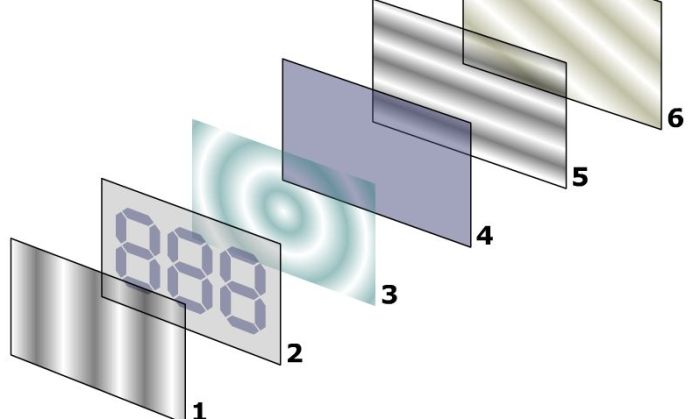Up to 50% Lower Mobile Display Power Usage with Kaneka’s New LCD Film
![By Yxnd3fbg (Own work) [CC-BY-SA-3.0 (http://creativecommons.org/licenses/by-sa/3.0)], via Wikimedia Commons](https://techtheday.com/wp-content/uploads/2014/05/close-up-of-an-LCD-panel.jpg)
By Yxnd3fbg (Own work) [CC-BY-SA-3.0 (http://creativecommons.org/licenses/by-sa/3.0)], via Wikimedia Commons
Last year, Japanese mobile display maker Sharp debuted the power-efficient IGZO display technology that is now being used by the company’s flagship mobile phones. This year, another company is introducing a new display tech that claims to bring mobile display power usage even lower. This new display technology is being introduced by Kaneka, specialty materials producer based in Japan. The company claims to have the display tech that can produce double the brightness of conventional mobile LCD displays or half of the backlighting the power requirement needed by a conventional LCD to produce the same level of brightness.
Power-Saving LCD Film
Kaneka’s power efficient display technology is centered on a new type of protective film for LCD panels. What it basically does is to let more light through to produce brighter images without requiring more power for a more powerful backlight. “More” here is estimated to be around double the amount of light current LCD technology is able to produce. Theoretically, this could mean a reduction in LCD power consumption by around 40% to 50%.
Kaneka’s power efficiency solution does not really create an entirely new LCD system. It simply introduces a new film that replace the conventional one that protects the LCD’s polarizing plate or the critical component responsible for polarizing the desired light before it reaches the color filters of the LCD. This protective layer is made of acrylic resin, providing the advantage of increasing light penetration. With it, the backlight can be reduced to half its typical brightness level without making the overall display output dimmer.
20% vs 10%
The phase difference film used in conventional LCD displays only allows around 10% of the light that comes from the backlight to go into to LCD color filter. With Kaneka’s protective film, however, up to 20% of light from the backlight is able to pass through. That’s double the brightness that could reach visible surface of an LCD display. However, it may not necessarily translate to a 50% decrease in display power consumption since backlighting is only one part of an LCD setup. There are other parts of an LCD that also use power. On the other hand, it is also worth pointing out that this does not necessarily translate to a 50% power usage reduction for a smartphone or mobile device that has a display that uses the Kaneko protective film. The LCD screens of most devices are only around 40% to 50% of the overall power consumption.
Comparison with OLED Tech
OLED is an efficient display technology because each pixel on it is a light source itself that can be completely turned off when not needed. As such, if you are fond of dark themes or backgrounds, you will likely be consuming only around 25% to 75% of the total power consumption an OLED display would have if it has all of its pixels are turned on. With LCD’s the backlight’s brightness is maintained even when a completely black image is being shown. Kaneko’s display power consumption reducing solution will certainly lower the amount of power used in LCD’s but it’s not yet close to the kind of efficiency OLED has.
Moreover, it is not yet clear whether or not Kaneko’s protective film will have any negative impact on the viewing angles and dynamic range of a display. OLED displays have impressive contrast ratios and their color reproduction (that used to be harshly criticized before) has now be significantly improved. The display on the Samsung Galaxy S5 smartphone is a proof to this. The Galaxy S5 display has been hailed by professional display experts at DisplayMate as the best display they have ever tested.
Availability
Unfortunately, Kaneka’s power usage reducing tech may is still far from hitting the shelves. There are no plans of mass productions yet. The latest reports say that the company is yet to ship samples of the film to LCD panel manufacturers in Japan for evaluation and further testing. The production of displays that will incorporate Kaneka’s technology will likely start only in the first month of next year. The actual Kaneka-tech-bearing devices may reach the market only in the second quarter of next year or the year after next.
![I, MrPlow [GFDL (http://www.gnu.org/copyleft/fdl.html), CC-BY-SA-3.0 (http://creativecommons.org/licenses/by-sa/3.0/) or CC-BY-SA-2.5-2.0-1.0 (http://creativecommons.org/licenses/by-sa/2.5-2.0-1.0)], via Wikimedia Commons](https://techtheday.com/wp-content/uploads/2014/05/microscopic-view-of-a-mobile-LCD-display.jpg)
I, MrPlow [GFDL (http://www.gnu.org/copyleft/fdl.html), CC-BY-SA-3.0 (http://creativecommons.org/licenses/by-sa/3.0/) or CC-BY-SA-2.5-2.0-1.0 (http://creativecommons.org/licenses/by-sa/2.5-2.0-1.0)], via Wikimedia Commons
Kaneko’s innovation is indeed a welcome development. This is the kind of technology manufacturers should be giving more attention instead of aiming for excessively high resolution displays on tiny smartphones.
